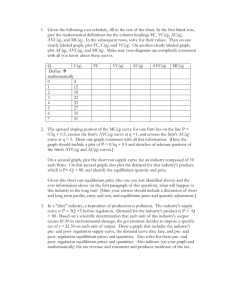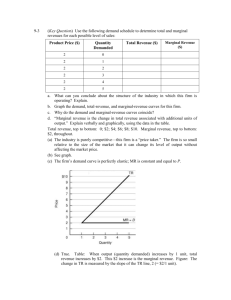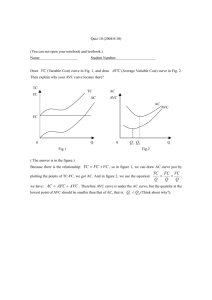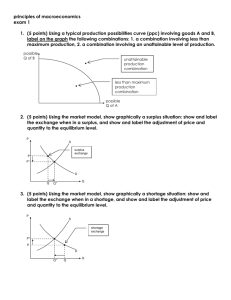Long Problems - faculty.bcitbusiness.org at 142.232.104.155
advertisement
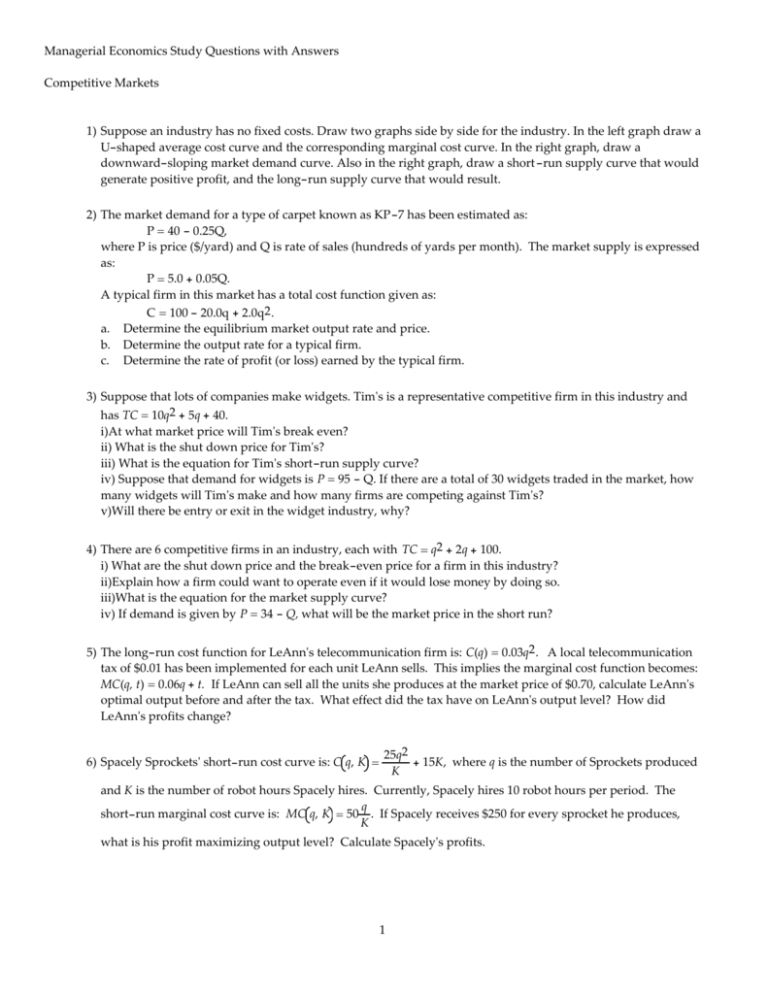
Managerial Economics Study Questions with Answers Competitive Markets 1) Suppose an industry has no fixed costs. Draw two graphs side by side for the industry. In the left graph draw a U-shaped average cost curve and the corresponding marginal cost curve. In the right graph, draw a downward-sloping market demand curve. Also in the right graph, draw a short -run supply curve that would generate positive profit, and the long-run supply curve that would result. 2) The market demand for a type of carpet known as KP-7 has been estimated as: P = 40 - 0.25Q, where P is price ($/yard) and Q is rate of sales (hundreds of yards per month). The market supply is expressed as: P = 5.0 + 0.05Q. A typical firm in this market has a total cost function given as: C = 100 - 20.0q + 2.0q2 . a. Determine the equilibrium market output rate and price. b. Determine the output rate for a typical firm. c. Determine the rate of profit (or loss) earned by the typical firm. 3) Suppose that lots of companies make widgets. Timʹs is a representative competitive firm in this industry and has TC = 10q2 + 5q + 40. i)At what market price will Timʹs break even? ii) What is the shut down price for Timʹs? iii) What is the equation for Timʹs short-run supply curve? iv) Suppose that demand for widgets is P = 95 - Q. If there are a total of 30 widgets traded in the market, how many widgets will Timʹs make and how many firms are competing against Timʹs? v)Will there be entry or exit in the widget industry, why? 4) There are 6 competitive firms in an industry, each with TC = q2 + 2q + 100. i) What are the shut down price and the break-even price for a firm in this industry? ii)Explain how a firm could want to operate even if it would lose money by doing so. iii)What is the equation for the market supply curve? iv) If demand is given by P = 34 - Q, what will be the market price in the short run? 5) The long-run cost function for LeAnnʹs telecommunication firm is: C(q) = 0.03q2 . A local telecommunication tax of $0.01 has been implemented for each unit LeAnn sells. This implies the marginal cost function becomes: MC(q, t) = 0.06q + t. If LeAnn can sell all the units she produces at the market price of $0.70, calculate LeAnnʹs optimal output before and after the tax. What effect did the tax have on LeAnnʹs output level? How did LeAnnʹs profits change? 6) Spacely Sprocketsʹ short-run cost curve is: C q, K = 25q2 + 15K, where q is the number of Sprockets produced K and K is the number of robot hours Spacely hires. Currently, Spacely hires 10 robot hours per period. The q short-run marginal cost curve is: MC q, K = 50 . If Spacely receives $250 for every sprocket he produces, K what is his profit maximizing output level? Calculate Spacelyʹs profits. 1 7) Conigan Box Company produces cardboard boxes that are sold in bundles of 1000 boxes. The market is highly competitive, with boxes currently selling for $100 per thousand. Coniganʹs total and marginal cost curves are: TC = 3,000,000 + 0.001Q2 MC = 0.002Q where Q is measured in thousand box bundles per year. a. Calculate Coniganʹs profit maximizing quantity. Is the firm earning a profit? b. Analyze Coniganʹs position in terms of the shutdown condition. Should Conigan operate or shut down in the shortrun? 8) The utilities commission in a city is currently examining pay telephone service in the city. The commission has been asked to evaluate a proposal by a city council member to place a $.10 price ceiling on local pay phone service. The staff economist at the utilities commission estimates the demand and supply curves for pay telephone service as follows: QD = 1600 - 2400P QS = 200 + 3200P, where P = price of a pay telephone call, and Q = number of pay telephone calls per month. a. b. c. Determine the equilibrium price and quantity that will prevail without the price ceiling. Analyze the quantity that will be available with the price ceiling (in the long-run). The city council realizes that the telephone company could curtail pay phone service in response to the ceiling. To prevent this, the council plans to impose a requirement that the telephone company must maintain the current number of pay phones. In light of this additional restriction, what will be the likely impact of the price ceiling? 9) In an unregulated, competitive market we could calculate consumer surplus if we knew the equations representing supply and demand. For this problem assume that supply and demand are as follows: Supply P = 4 + 0.116Q Demand P = 25 - 0.10Q, where P represents unit price in dollars and Q represents number of units sold each year. Calculate the annual value of aggregate consumer surplus. 10) The elected officials in a west coast university town are concerned about the ʺexploitativeʺ rents being charged to college students. The town council is contemplating the imposition of a $350 per month rent ceiling on apartments in the city. An economist at the university estimates the demand and supply curves as: QD = 5600 - 8P QS = 500 + 4P, where P = monthly rent, and Q = number of apartments available for rent. For purposes of this analysis, apartments can be treated as identical. a. b. c. Calculate the equilibrium price and quantity that would prevail without the price ceiling. Calculate producer and consumer surplus at this equilibrium (sketch a diagram showing both). What quantity will eventually be available if the rent ceiling is imposed? Calculate any gains or losses in consumer and/or producer surplus. Does the proposed rent ceiling result in net welfare gains? Would you advise the town council to implement the policy? 2 11) In a competitive market, the following supply and demand equations are given: Supply P = 5 + 0.36Q Demand P = 100 - 0.04Q, where P represents price per unit in dollars, and Q represents rate of sales in units per year. a. b. Determine the equilibrium price and sales rate. Determine the deadweight loss that would result if the government were to impose a price ceiling of 40 dollars per unit. 12) Suppose market demand is Q = 1000 - 4p. If all firms have LRAC = 50 - 5q + q2 , how many identical firms will there be when this industry is in long-run equilibrium? 13) All firms in a competitive industry have the following long-run total cost curve: C(q) = q 3 – 10q 2 + 36q where q is the output of the firm. a. Compute the long run equilibrium price. What does the long -run supply curve look like if this is a constant cost industry? Explain. b. Suppose the market demand is given by Q = 111–p. Determine the long-run equilibrium number of firms in the industry. 14) Demand for rice is given by P = 100 - Q and the supply of rice is given by P = Q - 20. The government imposes a guaranteed price of $60 for rice. i) What will be the impact of this program? Specifically, what price will consumers pay, what price will sellers receive, and how much money will the government pay? ii) What is the reduction in total surplus associated with this program relative to the efficient outcome? 15) Crazy Horse is one of many identical competitive firms producing horse shoes. Its cost function is given by C(Q) = Q2 + 4, where Q is the number of horse shoes produced. i) Give an equation for and graph the horse shoe industry long run supply curve. ii) Suppose the demand for horse shoes is given by Q = D(p) = 5000 - 500p. Graph the demand curve. Find the equilibrium price and quantity of horse shoes. iii) Bowing to pressure from the horse ranchers lobby, the government decides to impose a $1 per unit tax on horse shoes. What is the effect of the tax on the price paid by consumers and the equilibrium quantity? 16) Suppose that the domestic demand for bottled water can be expressed as Q = 200 - 4P and the domestic supply can be expressed as Q = 16P. If the world price of bottled water is $5, would domestic bottled water producers prefer a $3 per unit tariff on imported bottled water or an import quota of 40 units? 17) The current domestic demand for steel is P = 150 - 2Q and the current supply is given by P = 30 + Q. The world steel price is $40. The government decides to repeal the $10 tariff on steel. i) What is the impact of this bill? Specifically, what will be the change in domestic consumer surplus and producer surplus? ii) What will be the loss in government revenue from not collecting the tariff and how many more units will be imported? 3 Answer Key Testname: 6500_COMPETITIVE_MARKETS_LONG_PLROBLEMS 1) See the above figure. 2) a. Equate supply to demand to get Q. 40 - 0.25Q = 5.0 + 0.05Q 0.30Q = 35 Q = 116.7 (hundreds of yards per month) P = 40 - 0.25(116.7) = $10.825 / yard b. The typical firm produces where MC equals P. MC = -20 + 4q 10.825 = -20 + 4q q = 7.71 (hundreds of yards per month) c. The profit rate is as follows: R(Q) = PQ = (10.825)(7.71) = 83.461 TC = 100 - 20(7.71) + 2(7.71)2 = 64.69 Profit = $18.77 (hundreds / month) 3) i) ATC = 10q + 5 + 40/q and MC = 20q + 5. So setting ATC = MC we have 10q + 5 + 40/q = 20q + 5., which gives q = 2. At q = 2, MC= 45. Thus, the break-even price is 45. ii) AVC = MC or 10q + 5 = 20q + 5 or q = 0. At q = 0, MC = 5. Thus, the shutdown price is 5. iii) Q = 0 if P<5 and P = 20q + 5 if P>5. iv) Since Q = 30, we have P = 95 - 30 = 65. Setting MC = MR, we have 65 = 20q + 5 or q = 3. Since there are a total of 30 units produced, we know that there are 10 firms. Hence 9 firms compete against Timʹs. v) Entry as 65>45 = break-even price. That is, firms are making positive profits. 4) i) Break-even price is where ATC and MC intersect. ATC = q + 2 + 100/q and MC = 2q + 2. Thus the break-even quantity is where q + 2 + 100/q = 2q + 2 or 100/q = q or q = 10. ATC for 10 units is 10 + 2 + 100/10 = 22. The break-even price is 22. The shutdown price is where AVC = MC. AVC = q + 2. Thus the shutdown quantity is where q + 2 = 2q + 2 or q = 0. MC for 0 units is 2. The shutdown price is 2. ii) A firm would choose to operate even if it was losing money if it is covering its variable costs. If the firm shuts down, it will still have to pay its fixed costs so as long as it covers its variable costs the firm is doing better than shutting down. iii) MC = 2q + 2. For a competitive firm MR = P and the Firm sets MR =MC so we have P = 2q + 2 or q = (P - 2)/2. With 6 firms, the market quantity is 6*(P - 2)/2 or Q = 3P - 6. iv) The price is where Supply and Demand cross. That is where 34 - Q = (Q + 6)/3. This gives Q = 24 and thus P = 10. 4 Answer Key Testname: 6500_COMPETITIVE_MARKETS_LONG_PLROBLEMS 5) The profit maximizing output level is where the market price equals marginal cost (providing the price exceeds the average variable cost). To determine the optimal output level, we need to first equate marginal cost to the market price. That is, 2 MC(q,0) = 0.06q + (0) = P = 0.7 ⇔ q = 11 . 3 The average variable cost at this output level is: 2 2 2 2 AVC 11 = 0.03 11 = 0.35. Since P > AVC 11 , LeAnn will maximize profits at 11 units. LeAnnʹs profits are: 3 3 3 3 2 2 1 2 = 4 . π = Pq - C(q) = 0.70 11 - 0.03 11 3 12 3 With the tax, LeAnnʹs optimal output level requires: MC(q, 0.01) = 0.06q + (0.01) = P = 0.7 ⇔ q = 11.5. The average variable cost at this output level is: AVC(11.5) = 0.03(11.5) + .01 = 0.355. Since P > AVC(11.5), LeAnn will maximize profits at units. LeAnnʹs profit with the tax is: π = Pq - C(q) = 0.70(11.5) - 0.03(11.5) 2 + 0.01(11.5) = 3.9675. The tax reduces LeAnnʹs output and profit. 6) The profit maximizing output level is where the market price equals marginal cost (providing the price exceeds the average variable cost). To determine the optimal output level, we need to first equate marginal cost to the market q price. That is, MC q, K = 50 = P = 250 ⇔ q = 50. The average variable cost at this output level is: 10 AVC(50, 10) = 25q 25(50) = = 125. Since P > AVC(50, 10), Spacely will maximize profits at 50 units. Spacelyʹs profits 10 K are: π = Pq - C(q, 10) = 250(50) - 25(50)2 + 15(10) = 6,100. 10 5 Answer Key Testname: 6500_COMPETITIVE_MARKETS_LONG_PLROBLEMS 7) a. Given the competitive nature of the industry, Conigan should equate P to MC. 100 = 0.002Q Q = 50,000 To determine profit: π = TR - TC TR = PQ TR = $100 · 50,000 TR = 5,000,000 TC = 3,000,000 + 0.001(50,000) 2 TC = 3,000,000 + 2,500,000 TC = 5,500,000 π = 5,000,000 - 5,500,000 π = -500 Conigan is losing 500,000 per year. b. To determine if the firm should operate or shutdown, we must compare P to AVC. TVC AVC = Q TVC = TC - TFC TVC = 5,500,000 - 3,000,000 TVC = 2,500,000 2,500,000 = $50 AVC = 50,000 AVC = 50; P = $100 The firm should operate since P > AVC. 8) a. set Q D = Q S 1600 - 2400P = 200 + 3200P 1400 = 5600P P = $0.25 substitute into QD QD = 1600 - 2400(0.25) QD = 1000 b. QS = 200 + 3200(0.10) QS = 520 QD = 1600 - 2400(0.10) QD = 1360 There will be a shortage of 1360 - 520 or 840 calls. c. The telephone company would be expected to allow service to decline by not servicing broken phones, placing the required phones in very easily reserviced areas, and otherwise reducing the cost of complying with the requirement. 6 Answer Key Testname: 6500_COMPETITIVE_MARKETS_LONG_PLROBLEMS 9) We must calculate the area above the equilibrium price and below the demand curve. The equilibrium price is: 4 + 0.116Q = 25 - 0.10Q 0.216Q = 21 Q = 97.22 units per year. The area below the demand curve can be calculated after we know the height of demand at Q = 0 and Q = 97.22. At Q = 0, P = 25. At Q = 97.22, P = 25 - 0.10(97.22) = 15.28. Since demand is linear, we can use the difference of 25 and 15.28 or 9.72 as the height of the space under demand. Area = 1/2 b · h = (1/2)(97.22)(9.72) = $472.49 10) a. To calculate equilibrium set QD = Q S and solve for P. 5600 - 8P = 500 + 4P 5100 = 12P P = 425 Substitute P into QD to solve for Q QD = 5600 - 8(425) Q = 2200 QD = 5600 - 8P P = 700 - 0.125QD QS = 500 - 4P P = 125 + 0.25Q C.S. = area A C.S. = 0.5(700 - 425) × 2200 C.S. = 302,500 P.S. = area B P.S. = 0.5(425 - 125) × 2200 P.S. = 330,000 Sum of producer and consumer surplus is: 7 Answer Key Testname: 6500_COMPETITIVE_MARKETS_LONG_PLROBLEMS 302,500 + 330,000 = 632,500 b. Eventually the market will settle at the quantity supplied corresponding to $350 rent. QS = 500 + 4(350) QS = 1900 QD at P = 350 QD = 5600 - 8(350) = 2800 There will be a shortage of 900 apartments. Gain = Consumer surplus is area A Area A = (425 - 350) × 1900 = 142,500 Area B = loss in consumer surplus To find area B, first find consumer reservation price corresponding to an output of 1900. P = 700 - 0.125(1900) = 462.50 Difference Q = 2200 - 1900 = 300 Area B = 0.5(462.50 - 425) × (2200 - 1900) Area B = 5625 Loss in consumer surplus is 5625. Area C is loss in producer surplus not offset by gain in consumer surplus. Area C = 0.5(425 - 350) × (2200 - 1900) Area C = 11,250 c. Area A is a gain in consumer surplus, but it is offset by a loss in producer surplus. The net changes are thus B (lost C.S.) and C (lost P.S.). The policy thus results in a deadweight loss. The deadweight loss = lost C.S. + lost P.S. or 5625 + 11250 = 16,875. Deadweight loss = 16,875 8 Answer Key Testname: 6500_COMPETITIVE_MARKETS_LONG_PLROBLEMS 11) a. Equate supply and demand to get equilibrium values. 5 + 0.036Q = 100 - 0.04Q 0.076Q = 95 Q = 1,250 units per year The equilibrium price is P = 5 + 0.036(1250) = $50.00 per unit. b. With a price ceiling of $40, the deadweight loss is the triangle between supply and demand bounded by Q of 1250 and the new sales rate at P of 40. Rearrange supply in terms of P. P = 5 + 0.036Q or Q = -138.89 + 27.78P At P = 40, Q = -138.89 + 27.78(40) Qʹ = 972.31 units per year. The base of the triangle (rotated 90 degrees) is the vertical distance between the heights of supply and demand when Q = 972.31 Height of demand = P = 100 - 0.04(972.31) = 61.11 Height of supply = P = 5 + 0.036(972.31) = 40.00 Triangle base is the difference = 21.11 Height of triangle = Q - Qʹ = 1250 - 972.31 = 277.69 Deadweight loss = 1/2 b · h = (1/2)(21.11)(277.69) = $2,931. 12) The long-run market supply curve is horizontal at the minimum LRAC. LRAC is minimized when -5 + 2q = 0 or q = 2.5. At this level of output, LRMC = LRAC = 43.75. At this price, 825 units are demanded. If each firm produces 2.5 units in the long run, then 330 firms will be in this market. 13) a. Long run equilibrium is determined by (1) the minimum of the AC curves, and (2) the demand equation. The AC is at a minimum where AC=MC: Q=5, AC=MC = 11 Therefore, the long run price will be $11 and each firm will produce 5 units. b. The market quantity (from demand) is 100 and so 20 firms will exist in this market. The long run supply curve is flat at $11 because the price will always equal this due to free entry and exit of firms. 14) i) With a guaranteed price of 60, sellers are willing to supply 60 = Q - 20 or Q = 80. To be willing to buy this quantity, buyers are only willing to pay a price of P = 100 - 80 = 20. Therefore, the government is paying 60 - 20 = 40 per unit on 80 units or $3200. With this policy too many units are produced which creates a deadweight loss. ii) DWL = 400. 15) i) LRS is given by p = 4 and is a horizontal line (assume we have a constant cost industry). If you want to consider this an increasing or decreasing cost industry the answer to ii) and iii) will not be affected. ii) The demand is a downward sloping straight line. The equilibrium price and quantity are p = 4 and Q = 3000. iii) The tax will increase the total cost by Q($1 times the quantity produced Q). The tax will increase the price by $1 and the quantity sold in the market will decrease by 500. The quantity produced by each firm will be the same. 16) With an import quota, the new domestic price can be found by setting excess domestic demand equal to 40, or P = 8. With a tariff of $3, the new domestic price will be 5 + 3 = $8. The change in producer surplus is the same for both policies. Thus, producers will be indifferent between the two. 9 Answer Key Testname: 6500_COMPETITIVE_MARKETS_LONG_PLROBLEMS 17) i) With the tariff the domestic price is world price + tariff = 40 + 10 = 50. At this price domestic demand is 50 units and domestic supply is 20 units. Thus 50 - 20 = 30 units are imported. CS = 2500 and PS = .200. Tax collection is 300. Without the tariff the domestic price is the world price 40. Domestic demand is 55 and domestic supply is 10. The number of imports is thus 55 - 10 = 45. Since there is no tariff, government collections are 0. CS = 3025 and PS = 50. ii) Additional Imports = 45 - 30 = 15. Lost revenue = 300. 10



